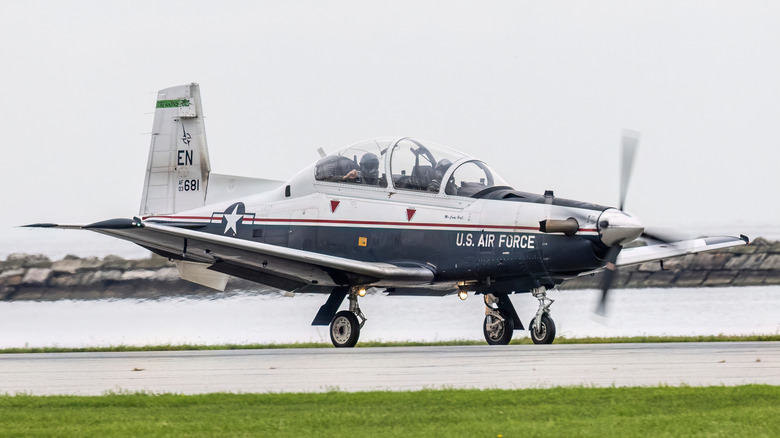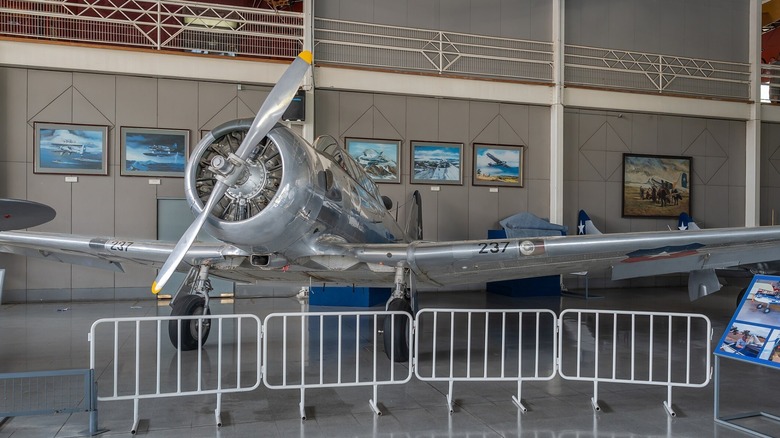Why Is The North American T-6 Texan Called The 'Pilot Maker?'
Just as no driver ever forgets their first car, pilots can have a real emotional attachment to a given model of aircraft, especially if it was one of the first they flew. This association will be strong for both past and present pilots with the T-6 Texan. This family of planes has many other names (such as the Harvard) but is known to many old hands as the Pilot Maker. The reason for this is simple: It was of crucial importance in teaching many early pilots their craft and a newer version of the aircraft continues to serve in that role.
Ace pilots who've distinguished themselves (whether in combat, other military, or civilian roles) started off as green as anybody else. This just highlights that training has always been vital to military aviators as well as civilian ones, as has a specialized training aircraft in which to do so. In that regard, the Lone Star Flight Museum deems the T-6 Texan "arguably the most important military trainer ever built." It's mind-boggling to think about how many pilots cut their teeth with this model, the demand for which became so high that more than 17,000 of them were manufactured for the use of U.S. forces and their allies around the world. They're user-friendly models in so many ways, like a trusty new rider's motorcycle, from reliability and ease of maintenance to their solid performance.
The origins of the T-6 Texan
The iconic T-6 Texan was designed by North American Aviation back in 1935 as a modified NA-16. With World War II looming on the horizon, the world had enormous aerial encounters ahead such as the Battle of Kursk and the Battle of Britain. The United States Army Air Corps can't have known that then, but it had been in the process of teaching pilots to use specialized aircraft for some time and the NA-16 was an earlier example of such a plane.
The AT-6, or Advanced Trainer, would follow. One standout quality of the Texan was just what a rugged and hardy model it was and still is. Smithsonian Magazine quotes Norm Goyer, an aviator formerly of the U.S. Navy, as stating the aircraft was equipped with "North American airframe, a Hamilton Standard prop, and a Pratt & Whitney engine. Nobody made any of those things any better."
1997 saw the official naming of the T-6 Texan II, Raytheon's contemporary model. A new aircraft it may be, but it extols the virtues the original model was known for. A PT6A-68 turbo-prop propels it to 320 miles per hour and offers 1,100 horsepower. These numbers, of course, don't exactly compare to the fastest fighter jets in the world, but the real key to the Texan II's performance is its weight combined with that power. The 6,500 pound (when empty) model can climb quickly, making it responsive and versatile. The T-6 Texan II is used to teach pilots from 14 different nations, including the United States, United Kingdom, Denmark, and Canada, as part of the Euro-NATO Joint Jet Pilot Training Program.
Why the Texan was, and is, such a great training aircraft
You might presume that a training aircraft would be like flying on 'easy' mode so as to not overwhelm those who are still learning how to fly an airplane. The thing about that assumption, though, is that a training aircraft must nonetheless be potent enough to lead naturally into the experience with other aircraft. The Texan, generally, was not a typical first aircraft for new aviators during the war. That role was served by models such as the Piper J-3 Cub, itself primarily used by the Civilian Pilot Training initiative at the time.
The most important virtue of the Texan is it's versatile, balanced, and practical to control yet certainly potent in its own way. On top of that, there's scope for both instructor and trainee pilot to swap seats and roles as appropriate. A general purpose model such as this one is perfect for teaching general transferable skills, meaning it can be used to teach aviators from different branches of the military.
New military pilots will become familiar with this aircraft quickly. In the United Kingdom, the Royal Air Force ensures new recruits progress to the model they will fly during service, but begin with a model designed for training. The Texan was designed for that very purpose and will typically occupy a recruit's time before they advance to something else. Experience in the Texan will give them what they need to officially claim their Wings, as so many pilots have in this family of aircraft, both literally and figuratively.


